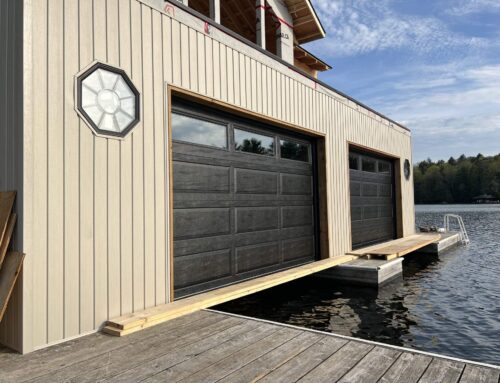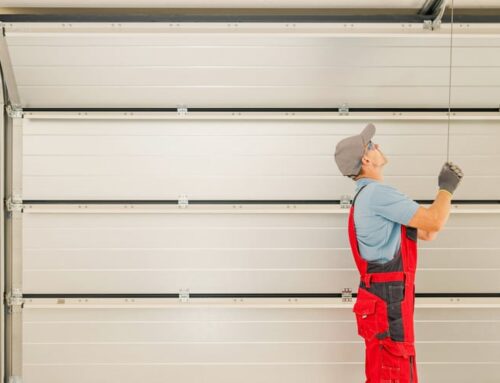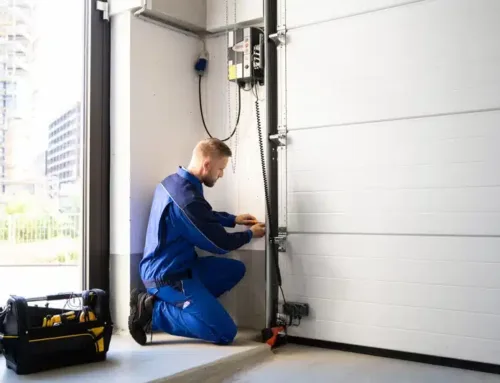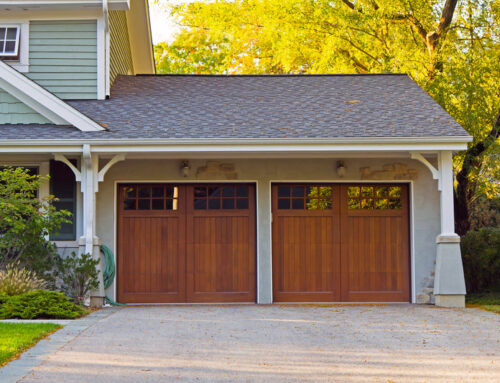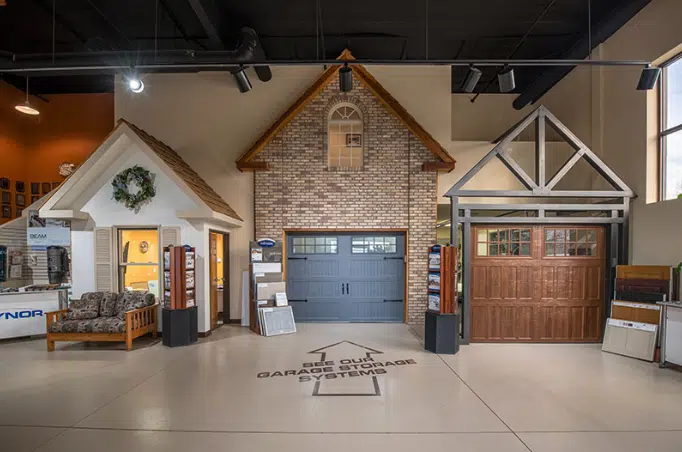
Choosing the right garage door is a big decision, whether you’re a homeowner looking to boost curb appeal or a business owner needing a reliable entry for daily operations. In Northern Colorado’s climate (with hot summers, frigid winters, and even high winds), your garage door plays a crucial role in aesthetics, security, functionality, and energy efficiency. A recent report found that replacing a garage door can recoup over 100% of its cost in added home value at resale, a testament to this upgrade’s importance. This comprehensive guide will walk you through everything you need to know, acting as your trusted advisor in navigating the world of garage door sales and installation.
We’ll start by distinguishing the needs of residential vs. commercial garage doors, then delve into door types, materials, insulation (R-values), opener technology, and security features. Along the way, we’ll highlight tips for cold climates and security enhancements and compare popular door styles. Let’s get started!
Residential Garage Doors: Enhancing Your Home’s Curb Appeal and Comfort
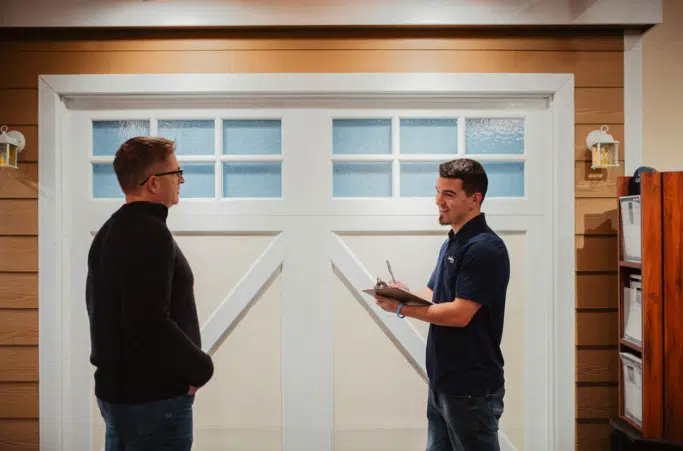
For homeowners, a garage door isn’t just an entry – it’s often a prominent facade feature that can make up 20–30% of your home’s front exterior. The right choice can dramatically improve your home’s curb appeal and resale value. Beyond looks, a garage door impacts your daily comfort and security. Here are key considerations for residential garage doors in Northern Colorado:
- Aesthetics and Style: You’ll want a door that complements your home’s architecture, whether classic carriage-house style or a sleek modern design. A well-chosen door can boost your home’s value (garage door replacements offer a 102% return on investment and make a great first impression. Consider whether you want windows for natural light or decorative hardware for character. (Tip: Front Range Raynor offers a wide range of residential garage doors to match various home styles, from rustic ranch to contemporary suburban.)
- Insulation and Comfort: Many Northern Colorado homes have attached garages or rooms above the garage. An uninsulated garage door is like having a giant open window in winter – your garage may only be about 10°F warmer than the outside air. Insulated doors help maintain a more stable temperature, which keeps adjacent rooms warmer and can lower home heating bills. Properly insulating your garage (door included) can cut energy use and save up to 15% on annual energy bills. We’ll discuss insulation (R-values) in detail later, but this is a top priority for homeowners in cold climates.
- Quiet Operation: If your garage is below a bedroom or next to the living space, the noise of the door and opener is a genuine concern. Residential doors paired with a smooth, belt-drive opener can minimize noise. Modern openers also have soft-start and soft-stop features for quieter opening and closing. Consider a belt-drive opener (more peaceful than a chain drive) or wall-mounted jackshaft openers for minimal vibration. Upgrading the opener mechanism can significantly improve daily life (see our section on openers and innovative technology below).
- Security and Safety: A garage door is a significant access point to your home. A flimsy or aging door can be an invitation to intruders. Approximately 9% of burglars enter homes through the garage, so it’s crucial to have a door that closes securely and an opener with updated security features (like rolling code technology that prevents code stealing). Modern doors have safety sensors for families to avoid accidents, and features like auto-reverse have been standard for years. We’ll cover high-security garage door features in a dedicated section, but as a homeowner, you’ll want to feel confident that your garage door is a substantial barrier when needed.
- Reliability and Maintenance: Finally, consider the long-term use. Colorado’s climate can be harsh on doors – intense sun, heavy snow, and wind gusts. A quality residential door with durable construction and good seals will last longer and require less upkeep. Look for warranties on springs or hardware, and consider scheduling regular maintenance. Working with a reputable local garage door installation and maintenance provider can ensure your door stays in top shape for years.
In short, Northern Colorado homeowners should seek a balance of beauty, insulation, quiet performance, and solid security in a garage door. Next, we’ll see how these priorities shift for commercial or business garage doors.
Commercial Garage Doors: Ensuring Security and Efficiency for Your Business
Businesses and commercial facilities have their own set of requirements for garage doors. Whether it’s a warehouse in an industrial park, an auto service center in Fort Collins, or a retail storefront needing a receiving door, choosing the right door can impact your operations and bottom line. Here’s what to consider for commercial garage doors:
- Durability and Heavy Usage: Commercial garage doors typically see high-frequency operation – opening and closing many times a day, often by different users. They must be built to withstand this wear and tear. Steel is a common choice for its strength. The North American garage door industry earns about $5 billion annually, primarily driven by commercial installations for warehouses and facilities. This means there are robust options available for heavy-duty use. Look for industrial-grade hardware (tracks, rollers, springs) rated for high cycles. A door failing at a busy business can halt operations, so durability is paramount.
- Security and Protection: Businesses often store valuable inventory or equipment behind garage doors. High-security features are a must. This might include heavier-gauge steel doors, internal locking mechanisms, tamper-resistant brackets, and integration with building security systems. For example, a rolling steel door (discussed later) offers excellent security against break-ins due to its interlocking slats and sturdy construction. Some commercial doors also offer automatic deadbolt locking each time the door closes for added protection. Investing in a high-security door can provide peace of mind if your business is in an area prone to vandalism or theft.
- Size and Customization: Commercial openings often come in non-standard sizes – think oversized loading dock doors or extra-tall bays for trucking. You’ll need to choose a door type that can be built to your required dimensions. Sectional doors can be large (standard in fire stations and warehouses), but rolling steel doors excel for wide or tall openings because they don’t require ceiling tracks and can be engineered for huge sizes. Also, consider if you need windows or full-vision panels (useful for auto shops or retail garages to allow light and visibility) or if a solid door is preferred for security/privacy. At Front Range Raynor, we’ve installed everything from large solid security doors to stylish glass-paneled commercial doors, tailoring each to the business’s needs, so know that customization is often possible when you work with a specialized commercial garage door provider.
- Insulation and Climate Control: Many businesses, such as heated warehouses or climate-controlled facilities, need insulated doors like homes. If you operate a workshop or showroom that gets cold, an insulated door will help maintain interior temperatures and save on energy costs. (Keeping a warehouse warmer can protect products and equipment from freezing temperatures.) Later in this guide, we cover what to consider for cold climates, which applies to commercial settings, too, like choosing high R-value doors and ensuring robust weather seals. In Northern Colorado, where winters are harsh, even commercial garages benefit from insulation to improve employee comfort and reduce heating bills.
- Operational Efficiency: Features that improve workflow can be important. High-speed doors (doors that open/close very fast) might be worth it in a logistics hub to minimize waiting time and reduce air exchange (keeping cold out). Automatic sensors or remote controls allow truck drivers to open doors without leaving their vehicles. Also, consider maintenance ease – commercial doors should be easy for technicians to service, with readily available parts and support. Downtime is costly for a business, so investing in quality and perhaps a maintenance plan is wise.
A business should prioritize a rugged, secure, and adequately sized door that fits its operation. Now that we’ve distinguished home vs. business needs, let’s explore the types of garage doors available and which might suit each scenario.
Comparing Sectional vs. Rolling Steel Garage Doors
You’ll encounter different types of door constructions when shopping for garage doors. The two most common categories, especially for larger openings, are sectional doors and rolling steel doors. Understanding the difference will help you decide which is right for your home or business.
Sectional Garage Doors: These are the doors most homeowners are familiar with. A sectional door is made of large horizontal panels (sections) hinged together. When the door opens, the sections ride on tracks that curve from vertical (when closed) to horizontal along the garage ceiling—the door sections neatly “section” up overhead. Sectional doors are popular for several reasons: they are widely available, relatively affordable, and versatile. Residential sectional doors often come in insulated versions and offer many design options (windows, panel designs, etc.). Commercial sectional doors work similarly and can be larger for warehouse bays or fire stations.
- Advantages: Sectional doors typically cost less upfront than rolling steel doors. They provide a tight seal on the sides and bottom (important for weather). They can be insulated or non-insulated. Maintenance, like replacing a single damaged panel, is straightforward. However, they require space inside the garage for the horizontal tracks, which means your ceiling space must be clear. Most standard overhead garage doors you see in neighborhoods are sectional.
- Considerations: Sectional doors are usually made of steel (or wood/composite for homes) in panel form. Note that sectional door panels and hardware are often lighter-duty than rolling steel for commercial uses. For example, commercial sectional panels might be made of 24-gauge steel, while rolling steel slats can be 22-gauge or heavier. This means extremely high-security or high-cycle industrial settings might push a sectional door to its limits over time. However, sectional doors perform well for moderate use and are easily budget-friendly.
Rolling Steel Garage Doors (Roll-Up Doors): Rolling steel doors (also known simply as roll-up doors or coiling doors) are constructed from many narrow slats of steel that roll up into a coil above the opening. You’ve likely seen these on commercial storage units, service counters, or industrial facilities. Instead of bending along tracks, a rolling door winds around a drum directly above the door opening. The key characteristics are durability and space-saving design, because they don’t need ceiling tracks. Rolling steel doors are great where interior space or headroom is limited. They are commonly used in commercial and industrial settings that demand security.
- Advantages: Rolling steel doors are incredibly robust and long-lasting. They are built to withstand heavy usage and can often last 20-30 years or more with minimal maintenance in commercial environments, essentially the lifetime of the building. The slatted design and heavy steel construction make them resistant to impact or forced entry (hence, a good choice for high-security needs). They can also fit huge openings that sectional doors might not handle. Another advantage is that all the moving parts are generally compactly mounted – the door rolls above the doorway, requiring no ceiling tracks extending back into the building. Using that ceiling space for lighting, sprinklers, or storage can be a benefit.
- Considerations: The trade-offs for rolling steel are higher cost and sometimes noise. They tend to cost more upfront than a comparable sectional door because of the heavier materials and complex spring barrels. Also, the many slats and hinges can produce more noise when a rolling door operates than a well-insulated sectional door. Maintenance is low-frequency, but it can be a specialized job when needed (e.g., replacing a worn-out spring or slat). Rolling doors also typically have a more utilitarian appearance – great for use in the back of a building or an industrial setting, but not as customizable in style as sectional doors. For example, you won’t usually have decorative windows in a rolling steel door (though perforated or grille-style rolling doors exist for visibility).
Which to Choose? For most homes and standard commercial garages, sectional doors are the go-to solution due to their balance of price, insulation, and style options. Nearly all residential garage door sales in Northern Colorado will be sectional doors. Residential garage and overhead doors account for over half of all global garage door sales by volume. On the other hand, rolling steel doors shine in specific applications. If you need maximum security (like a pharmacy counter or industrial warehouse), have an extra-large opening, or want to avoid ceiling tracks. Many businesses use sectional doors on loading docks but might opt for a rolling steel door for a high-security storage area or a frequently used bay where longevity is worth the cost. It’s not strictly “one is better than the other” – it depends on your needs. Later, in the security section, we’ll touch on how rolling doors can enhance security. But in summary, homeowners will almost always choose sectional doors (with design enhancements to boost curb appeal). At the same time, business owners may weigh the choice between sectional and rolling steel depending on the use case, budget, and space.
Garage Door Materials: Steel, Wood, Aluminum, or Composite?

Once you’ve thought about the door type, another fundamental choice is material. The material affects the door’s appearance, durability, maintenance needs, insulation, and cost. Here’s a jargon-free rundown of the standard garage door materials and their pros and cons:
- Steel: The most popular material for garage doors, steel offers an excellent mix of affordability and strength. Modern steel doors can be single-layer (just a steel skin), double-layer (steel + insulation), or even triple-layer (steel + insulation + back steel skin) for extra rigidity and insulation. Steel is durable and low-maintenance – it won’t warp or crack, and it resists the elements well with a good factory finish. It’s also versatile in style: it can be stamped with various designs and even overlaid or painted to mimic wood grain. Due to its popularity, steel is often the most cost-effective option, especially for standard residential doors. If insulated, it can be quiet and energy-efficient, too. Downside: Steel can dent if struck (e.g., a basketball or hailstorm), and if the finish gets scratched, it may rust over time. Also, a non-insulated steel door will readily conduct heat and cold, making the garage hot or cold, so in Northern Colorado, opt for an insulated model to avoid the garage becoming an icebox or oven. Overall, a steel door is an excellent choice for most homes and businesses due to its strength, low upkeep, and various designs.
- Wood: Wood garage doors are the classic, timeless choice. They offer natural beauty and can make a statement on upscale homes. Wood can be custom-crafted in carriage-house styles, modern plank designs, and more. It’s also a good natural insulator (though typically not as high an R-value as foam-insulated doors). Real wood doors (made from cedar, redwood, etc.) can boost curb appeal for historical or high-end homes. Downside: Wood requires the most maintenance. In Colorado’s dry, sunny climate, wood can dry out; in wet weather, it can absorb moisture. Without regular staining or painting, a wood door can crack, warp, or rot. They are also the most expensive option upfront, primarily if custom-built. Wood doors are heavy, so you need a robust opener and springs, and manually operating them is harder. However, with proper care, a quality wood door can last and will certainly stand out in appearance. Many homeowners who love the look but not the upkeep of real wood now opt for composite doors (following item) that imitate wood.
- Aluminum: Aluminum garage doors are similar to steel in appearance but are made from aluminum, a lighter, rust-proof metal. Many contemporary-style garage doors use aluminum frames with large glass panels to create a modern, full-view look (often seen in contemporary homes, car dealerships, or fire stations). Aluminum is naturally resistant to rust and corrosion, which makes it great for humid or coastal environments (and a plus for any climate). It’s also very lightweight, which puts less strain on the opener and hardware. This material is often a bit cheaper than steel, and aluminum supports that well if you want a lot of glass in your door. Downside: Aluminum’s lightness comes at the cost of durability – it dents more easily than steel and generally isn’t as strong. A stray bicycle bump or hail can leave a mark more readily. Also, while aluminum itself doesn’t insulate much, many aluminum doors are offered with insulated glass or panels to improve efficiency. For Northern Colorado, if you’re considering a full-glass look, be aware of heat loss through the glass (you’ll want double or triple-pane insulated glass). In summary, aluminum doors are ideal for a modern aesthetic and low-maintenance longevity (no rust!), but ensure the thinner metal meets your durability needs.
- Composite/Faux Wood: Composite garage doors are a newer category that aims to look like wood with less upkeep. These doors are often constructed with a steel core for strength and a composite overlay (made from wood fibers, resins, or sometimes fiberglass) that mimics wood grain. The result is a door that, from the curb, looks like real wood but won’t rot or warp and doesn’t need annual painting. Composite doors are also well-insulated because they’re typically multi-layer (the insulation is sandwiched between the steel and composite skin). They are a “best of both worlds” option. Downside: The cost for composite doors is generally higher than basic steel doors (you’re paying for the cosmetic upgrade), though usually still less than premium real wood. Also, while the composite skin is low maintenance, you still need to clean and occasionally refinish it to keep it looking its best (some fading can occur over many years). And unlike solid wood, if the face gets damaged, you can’t simply sand and refinish a deep scratch – severe damage might require panel replacement since composites aren’t as easily repairable in a patchwork way. Nonetheless, composite wood doors have become very popular for homeowners who love the warmth of wood but want a more carefree ownership experience. They often come in styles resembling carriage house wood doors or modern wood tones.
In addition, there are other niche materials like fiberglass (lightweight and won’t rust but can become brittle in extreme cold) and vinyl (very durable and dent-resistant, but limited in design and can yellow over time). However, steel, wood, aluminum, and composite cover the vast majority of garage door choices you’ll encounter.
Key Tip: When choosing material, think about maintenance vs. appearance. Steel and aluminum are easiest to maintain (occasional cleaning and repainting after many years). Wood and composites offer elevated style but with more upkeep or cost. Also, consider your local climate: in Northern Colorado, the sun is intense (which can fade finishes), and the winters are cold (so insulation is essential for metal doors, and wood must be sealed against moisture from snow). Many homeowners today opt for insulated steel or composite doors as a happy medium.
Insulation and Energy Efficiency: Understanding R-Values
Northern Colorado experiences cold winters and hot summers, so garage door insulation can significantly affect your comfort and energy bills. If your garage is attached to your house or you use it as a workspace, insulation should be a key factor in your door choice. Here’s what to know:
What is the R-value? R-value measures thermal resistance – how well a door resists heat flow. The higher the R-value, the better the insulation. Garage doors can range widely in R-value. For example, a basic uninsulated door has R-0 (no significant insulation). Add a Styrofoam backing, and you might get R-6 or R-8. Premium polyurethane-filled doors can achieve R-12, R-16, or even R-20+. (Depending on thickness and construction, one major manufacturer’s doors range roughly R-6.3 up to R-20.4.) Higher R-values mean a warmer garage in winter, a cooler garage in summer, and less work for your home’s HVAC system if the garage is attached.
How Much Insulation Do You Need? It depends on your climate and usage. In a cold region like Colorado, we recommend a well-insulated 2-layer or 3-layer door if the garage is attached to the living space. An R-value in the teens (R-12 to R-18) is excellent for most homeowners’ needs, providing a substantial buffer against the weather. Insulation might be less crucial for detached garages or storage sheds, but it also adds to door strength and noise reduction. If you heat your garage or have water pipes, a higher R-value (and even an insulated garage space) can prevent freezing issues. On the commercial side, if you operate a temperature-sensitive facility (food storage, etc.), you may need doors with high R-value and even heated seals. For standard warehouses, an insulated door still helps reduce heating costs. In short, in cold climates, go with as much insulation as feasible within your budget – you’ll appreciate it in January when your garage isn’t bone-chilling and your adjacent rooms stay cozier.
Door Construction and Insulation Types: The insulation performance of a door isn’t just the material, but how it’s built. There are two common insulation types in garage doors:
- Polystyrene panels: These are rigid foam boards inserted into the door panels. They add insulation (and some rigidity) but don’t fill every gap. This is common in mid-level doors (often yielding R-values around 6-10).
- Polyurethane foamed-in-place: This is a higher-end method where liquid foam is injected between the door skins and expands, bonding to the door. It fills all voids and adds structural strength. Doors with this insulation can reach higher R-values (12-20+) and feel more solid and quiet because the foam stiffens the structure.
When shopping, the door spec sheet will list an R-value or sometimes a U-factor (U-factor is essentially the inverse of R for the whole door assembly; a lower U-factor is better). The R-value is a handy comparison tool for simplicity – remember, a higher number means a more energy-efficient door.
Energy Savings and Comfort: An insulated door can make a noticeable difference. Keeping the garage warmer in winter reduces the cold air that can seep into your home from the garage. ENERGY STAR estimates that insulating a garage (door included) and the rest of your home can shave up to 15% off heating and cooling costs. Moreover, an insulated door often has a quieter operation (the insulation dampens the rattle and vibration of the door panels). It also helps prevent dew or frost on the inside of the door on frigid days. Homeowners in Northern Colorado often tell us one of the biggest perks of an insulated door is simply the comfort of getting into a car that’s not ice-cold in the morning because the garage holds some heat overnight.
Weather Seals: Insulation isn’t just in the door panels – don’t overlook the seals. A good garage door will have:
- A bottom seal (astragal): a rubber or vinyl strip that compresses against the floor to keep out drafts, water, and pests.
- Weatherstripping along the sides and top: to seal the gaps between the door and frame when closed.
- For commercial or high-end residential, sometimes even interlocking panel joints with thermal breaks improve the seal.
In cold climates, ensure your installer properly seals the door. Ask for adjustments or better sealing if you see daylight or feel a draft. Those little gaps can leak a lot of air. Also, vinyl seals can harden in extreme cold; there are special cold-weather seal materials if needed.
To sum up, invest in a well-insulated garage door if energy efficiency or comfort is a concern. It will pay off lower energy bills, provide a more usable garage year-round, and even add resale value (buyers in Colorado appreciate when a garage is properly insulated). Next, let’s move from the door itself to the technology that operates it – the opener and other innovative features that can enhance functionality.
Garage Door Openers and Smart Technology
A garage door isn’t handy if it doesn’t open and close reliably. That’s where the garage door opener comes in – and today’s openers are more advanced than ever. When upgrading your door, it’s also a great time to evaluate your opener and see if a newer model could improve convenience, security, and connectivity.
Types of Garage Door Openers: The opener is a motorized device that lifts and lowers your door. The common types are:
- Chain-drive openers: These use a metal chain (like a bicycle chain) to pull the door. They are strong and budget-friendly, suitable for heavy doors. However, they tend to be the noisiest – you’ll hear the chain rattle. These are very common in older installations.
- Belt-drive openers: Instead of a chain, these use a rubber-like belt. They are much quieter, making them popular for attached garages. They cost more than chain drives, but the noise reduction is worth it for many homeowners. Belt drives still offer plenty of strength for most doors.
- Screw-drive openers: These use a threaded steel rod. They have fewer moving parts than chains or belts, so maintenance is low, and noise is moderate (quieter than chains, maybe similar or a bit louder than belts). Screw drives can be a good middle-ground, but they’ve lost some popularity to belt drives in recent years.
- Jackshaft (wall-mounted) openers are mounted on the wall beside the garage door and directly turn the torsion spring shaft. They free up ceiling space (no rail needed) and are quiet and smooth. Jackshaft openers (like the LiftMaster 8500 series) are great for garages with high ceilings or if you want that ceiling cleared (for storage or aesthetics). They are pricier, but many high-end installations choose these for their sleek operation.
- Smart Automatic Openers: Most new openers, whether chain, belt, or jackshaft, now come with innovative technology built in or as an option. “Smart” means they can connect to your Wi-Fi and be controlled via a smartphone app. This lets you get alerts, open/close the door remotely, and integrate with smart home systems (like Amazon Alexa or Google Assistant, or services to allow package deliveries into your garage).
Why consider a new opener? If your current opener is 10-15 years old, a new model could offer significant benefits:
- Quieter Operation: As noted, switching from chain to belt or jackshaft will reduce noise. This can be a huge quality-of-life improvement if bedrooms are above the garage.
- Smartphone Control: No more worrying if you left the garage open – you can check the app and close it from anywhere. You can also receive notifications (e.g., “garage door opened at 3:47 pm”), which is excellent for security and peace of mind. Smart openers can often be programmed to automatically close after a particular time or temporarily open for trusted visitors. Given that by 2025, more than 57% of U.S. homes are expected to have smart home devices, including smart garage door openers, this is becoming a standard feature.
- Improved Security: New openers have rolling code technology (every time you use the remote, a new code is generated, thwarting code-stealing devices). Some models even include an automatic garage door lock – for example, LiftMaster’s Secure View openers can hook up to a deadbolt that engages when the door closes, making it virtually impenetrable. These auto-locking openers physically bolt the door when down, adding a layer of security beyond the standard trolley engagement.
- Battery Backup: An opener with a battery backup is invaluable in areas prone to power outages (think winter storms). It will function for a limited number of cycles during an outage, so you’re not stuck. California even mandated this feature on new openers after people got trapped during wildfires. It’s not mandated in Colorado, but it’s certainly nice to have if you live in a rural area or want that emergency capability.
- Soft start/stop and motion detection: Many modern openers start slowly, speed up, and slow down before stopping. This reduces wear and makes the operation gentler. Some openers also have motion-triggered lighting (the garage light comes on when it detects movement, so you’re not in the dark).
When you purchase a new garage door, pairing it with a modern opener can complete the package. Professional installers (like our team at Front Range Raynor) can ensure the opener is adequately sized (horsepower) for your door and that all the innovative features are set up for you. A 1/2 HP or 3/4 HP opener for most single or double-car garages is sufficient; hefty custom wood or oversized commercial doors might need 1 HP or higher.
Don’t Forget Maintenance and Safety: With any opener, test the auto-reverse safety periodically (place a roll of paper towels under the door; it should reverse upon contact). Also, test the photoelectric safety sensors (the door should reverse if the beam at the bottom is broken). These are critical safety features to prevent injury or damage. New openers will have these by default, but they only help if they’re functioning and properly aligned.
To wrap up, a garage door opener is the unsung hero of your garage system – upgrading to a new, brilliant, quiet opener can greatly enhance daily convenience and add an extra layer of security. Next, we’ll focus on security features and what a “high-performance” garage door can do to protect your property.
How to Improve Security with a High-Performance Garage Door
Garage doors are not just about looks and insulation – they are one of the largest entrances to any property, and thus, a potential security weak point if not properly equipped. “High-performance” garage doors in the context of security means doors built and outfitted to prevent unauthorized entry, resist damage, and protect your assets. Here’s how you can improve garage security:
- Choose a Strong Door Construction: This is your first line of defense. A flimsy single-layer door is easier to breach than a reinforced one. For residential security, consider a steel door with multiple layers (steel + insulation + steel), harder to bend or break through than a thin aluminum or hollow wood door. Many high-end residential doors even have steel backing, improving insulation and making the door sturdier against impact. For businesses, rolling steel doors are often the go-to for security because of their heavy-gauge steel slats and rugged design. They can withstand attempts to pry or kick them far better than light-duty sectional panels. If opting for sectional, there are security-rated sectional doors, too – look for those with thicker gauge steel and perhaps internal bracing. Additionally, suppose wind is a concern (and in parts of Northern Colorado, strong winds are indeed common). In that case, a wind-rated door protects against weather and is inherently stronger against forced entry as well (it has extra reinforcements to handle wind load).
- High-Quality Hardware and Track System: A door is only as secure as its weakest link. An intruder can knock cheap plastic rollers or flimsy tracks out of alignment. Ensure your door has heavy-duty hardware – steel rollers (or at least rollers with steel stems and ball bearings), robust hinges, and solid track anchoring. Torsion springs (mounted above the door) are generally more secure and durable than extension springs (side-mounted), which can be more of a safety hazard if they break. Some security-conscious homeowners also install shielding over the opener release cord inside the garage to prevent phishing attacks (where a burglar fishes a wire over the top to pull the emergency release). There are products or DIY methods to guard the release, or you can secure the release with a zip-tie (that still breaks in an emergency but deters casual tampering).
- Automatic Locks and Smart Monitoring: As mentioned in the opener section, certain openers have automatic locking bolts that engage when the door closes. This adds a deadbolt to your garage door – a fantastic security feature. If your opener doesn’t have this, consider aftermarket manual slide locks (standard on doors – a little latch that you can slide closed from inside). Just be careful to turn off the opener when engaged so you don’t accidentally run it. Innovative technology also helps security: you can get alerts on your phone if the door opens at an odd time, and you can check the status remotely. Some smart garage cameras even let you see inside your garage. If you’re going for maximum security, integrate your garage door into your home security system – e.g., a contact sensor on the door to alert if it’s opened or even an alarm that triggers if forced open. A high-performance security setup might also include motion-sensing lights around the garage and outdoor cameras, complementing the strong door by deterring intruders before they even touch it.
- Secure Garage Door Windows (or Choose None): Windows in a garage door are a double-edged sword. They add style and light but can pose a security risk if not done right. Opt for reinforced or double-pane glass that’s harder to break if you want windows. Place them high up in the top section, not at an intruder’s eye level. Frosted or tinted glass is wise, so thieves can’t easily scope out what’s inside your garage or see if a car is gone. Some homeowners forego windows entirely for maximum security – it’s about your neighborhood and comfort level. If your door has older, thin windows, you can apply security film to make them more shatter-resistant.
- Consider Commercial-Grade or Specialty Security Doors: For businesses or facilities requiring top security, manufacturers offer options like steel roll-up security grilles, fire-rated doors (which also often are heavy-duty), or even bullet-resistant doors for high-risk environments. These go beyond the needs of a typical homeowner, but it’s good to know they exist. A “high-performance” door in a commercial sense might mean it’s high-speed and high-security, for instance, a rapid roll door that reduces the time the door is open (less opportunity for someone to slip in) and that has automatic locking when shut.
- Regular Maintenance and Vigilance: Security isn’t a one-time setup – maintain your door. An aging door with gaps or a broken lock invites trouble. Inspect your garage door annually: Are the hinges and brackets tight? Do the springs and opener function properly so the door closes fully? Is the bottom seal intact to prevent someone from prying up the door easily? Keeping the door in good shape ensures it performs as designed regarding security. If you live in an area with frequent break-ins, you might even consider reinforcing struts on the door (steel U-bars running across the inside to stiffen it). These are often used for wind load reinforcement, but also make bending the door harder.
In summary, achieving a secure garage door setup involves strong materials, advanced locking technology, and proactive maintenance. Investing in a high-performance door and opener is well worth considering, as garages are a known target for thieves (again, about one in eleven burglars get in through the garage). By fortifying this entry point, you significantly improve your overall security profile for your home or business. Remember, even the best door should be complemented by good habits – keep it closed when not in use, and don’t leave the opener remote in an unsecured car outside. With a robust door and a little vigilance, your garage will be an exceedingly tough nut to crack.
What to Consider When Buying a Garage Door for Cold Climates
Living in Northern Colorado means dealing with freezing winters, spring hail, and large temperature swings. These conditions should influence your garage door purchasing decision. A door that performs well in Florida might struggle here. So, here’s a checklist of what to consider for cold climates:
- Insulation (High R-Value): As discussed earlier, insulation is critical. Opt for an insulated door (at least a double-layer door with polystyrene or a polyurethane insulated door) to keep your garage warmer. Not only does this help your comfort and energy bills, but it also can protect items in your garage. For example, your car’s battery will fare better in a garage that isn’t freezing – car batteries can lose up to 50% of their output in sub-zero temps. Likewise, paint, cleaners, or other chemicals stored in the garage will be less likely to freeze or degrade. An insulated door also means your garage door opener will have an easier job (the door is more rigid and slightly lighter if foam-filled) in cold weather.
- Quality Weather Seals: Make sure the door you choose has good weather stripping. Look for features like a double-lip bottom seal or a thermally broken threshold in cold climates. Some premium doors have a thermal break in the metal (so the cold doesn’t transfer from the front face of the door to the back). Check that side seals are included and that they are a cold-resistant material that stays flexible. A snug seal keeps out cold air, snow drifts, rainwater, and critters seeking warmth. Garage door seals can harden and crack over time, so plan to replace them occasionally (an affordable upkeep item).
- Durability in Extreme Conditions: Cold weather can make some materials brittle. If you are considering a fiberglass door, ensure it’s rated for cold (fiberglass can crack in very low temperatures if of poor quality). Steel is generally fine in the cold, but make sure all moving parts are hardy: nylon rollers can sometimes flatten in extreme cold (consider sealed metal rollers), and cheap plastic components may snap. Springs can lose some tension in cold weather as the metal contracts – this is normal, but high-quality torsion springs will handle it better and last longer. Also, lubricants matter: the door’s springs and hinges should be lubricated with a low-temperature grease so they don’t gum up in winter. When you have your door installed, ask the installer what lubrication they use and plan to maintain it each year before winter.
- Wind Load and Reinforcement: Colorado’s Front Range can see powerful wind gusts, especially if your property is open. An uninsulated, thin door can get blown inward or rattle excessively in high winds. Insulated doors are usually sturdier due to the sandwiched construction. Consider a door with wind load reinforcement if you’re in a particularly windy locale or have a wide door span (16-foot two-car garage, for example). Many manufacturers offer an option or model that meets specific wind ratings (even if we’re not coastal, those features help in prairie winds). These doors have additional bracing and heavier gauge tracks, which means a more robust door.
- Cold Weather Opener Features: While the door itself is crucial, in cold climates, you should also consider your garage door opener’s performance in winter. Hydraulic fluid in some openers (less common now) could thicken – most openers are electric and fine in the cold, but battery backups can lose efficiency in the cold (so test them). If you live in an area where power outages happen in winter storms, a battery backup opener is an excellent idea so you’re not left out in the cold. Additionally, extreme cold can affect the safety sensors or limit settings – a professional installer will typically set the force and travel limits appropriately but know that if your door ever starts acting up in winter (reversing unexpectedly, etc.), it may just need a slight adjustment or lubrication – common in cold climates and not a big issue.
- Finishes and Materials for Moisture: Snow and ice mean moisture. If you opt for a wood door, ensure it’s properly sealed on all sides (including the bottom edge) to prevent moisture absorption. For metal doors, see that the finish is a high-quality powder coat or paint that resists salt and water. In areas where roads are salted, that salt can come in on your car and drip onto the bottom of the door – a recipe for rust if the door’s bottom section isn’t well protected. Many doors have a galvanized layer plus paint, which helps. Also, stainless steel hardware (hinges, screws) can be beneficial – ask if that’s an option, or at least spray the hardware with a protectant if rust is a concern.
- Heat Loss When Open – Consider Your Usage: One thing to consider in cold climates is how often and how long you open your door. Even the best-insulated door does nothing when it’s open! If you frequently use the garage (say, a workshop where you’re in and out of a commercial service bay), you might consider a high-speed door or an air curtain to minimize heat loss during operation. For homeowners, this usually isn’t an issue (you open, drive out, close it), but for businesses, it can be. A high-speed commercial door will shut quickly behind a vehicle, preserving interior heat.
Cold climates demand a well-built, well-insulated door that can withstand the weather. It’s worth investing more upfront for features like insulation and quality hardware, as they will pay dividends in comfort and longevity. The good news is that manufacturers design many garage doors with these exact conditions in mind, and a Northern Colorado garage door specialist can guide you to models that hold up well here. As a bonus, what’s suitable for cold weather (insulation, sturdy build) is also ideal for hot summers, keeping your garage cooler, so you get year-round benefits.
Conclusion: Making an Informed Choice
Upgrading or choosing a new garage door is a significant project, but armed with the correct information, you can make a choice you’ll be happy with for decades. We’ve covered how residential and commercial needs differ, explored various door types (sectional vs. rolling steel), examined materials from steel to wood to composites, discussed insulation and why R-value matters (especially in Northern Colorado), looked at modern opener technology, and reviewed security and climate considerations. It’s a lot to digest, but it all boils down to finding a door that meets your specific needs – maximizing curb appeal for your home, ensuring security and efficiency for your business, or simply staying warm and worry-free through the winter.
Here are a few final tips as you move forward with your garage door decision:
- Work with a Reputable Dealer/Installer: Installation quality is as important as the door choice. A professional installer will ensure your door is correctly balanced, sealed, and set up. They can also be a wealth of knowledge in helping you pick the right door. (If you’re in Northern Colorado, feel free to drop by the Front Range Raynor showroom in Fort Collins – seeing and touching the door options in person can be invaluable, and our experts are happy to answer questions in a non-pressured way.)
- Consider the Long Term: A garage door is an investment. A higher-quality door might cost more now, but it saves you in heating costs, lasts longer, and adds more value to your property. Also, factor in maintenance – if you do not want to repaint a door every few years, maybe opt for steel or composite over wood.
- Don’t Neglect Aesthetics: While we’ve talked much about the technical side, remember that the garage door is a massive part of your home’s exterior look. Choosing a design and color that complements your home will make you happy whenever you pull into your driveway. Many manufacturers have design tools that allow you to upload a photo of your house and try different door styles. A beautiful, high-quality door can transform a home’s look and even improve its appraisal value by up to 4%, according to some studies (not surprising, given its ROI).
- Stay Updated on Technology: If you’re the type who enjoys smart home conveniences, make sure your new garage door opener is compatible. Features like integration with Amazon Key (for in-garage deliveries) or HomeLink in your vehicles can make life easier. Technology in the garage door world has advanced significantly, and it’s worth taking advantage of those advancements.
Considering all the factors outlined in this guide – from the basic construction to the finishing touches – you’ll be well on your way to selecting the perfect garage door for your home or business. It’s not just about closing off an opening; it’s about enhancing your property’s appearance, energy efficiency, and security in one smart move. Here’s to finding a garage door you love that has served you well for many years!


